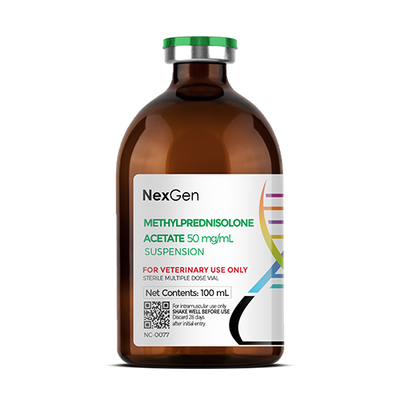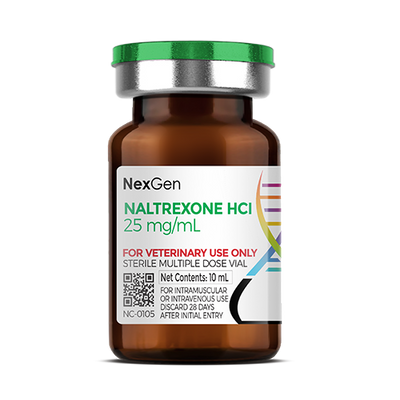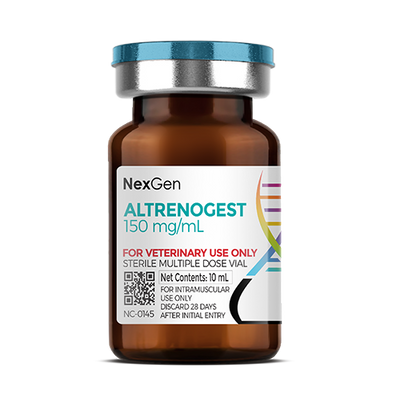
Buserelin Acetate 1 mg/mL, Injection, 10mL
Login for pricing
- Brand
- Mixlab
- SKU:
- NC-0046
- Product Type:
- Injectable
- Size:
- 10ml
- Administration:
- Intramuscular
- Therapeutic Class:
- GnRH Agonist
Equine Buserelin
The administration of hormones to mares for the purposes of breeding management is an essential utility in the equine practitioner’s toolkit. The proper administration of specific hormones to broodmares may be employed to prevent reproductive disorders, to serve as an aid to treating reproductive disorders or hormonal imbalances and to optimize reproductive efficiency (i.e., through the induction of estrus or ovulation).
When administered exogenously, such hormones act to control the duration and onset of the stages of the estrous cycle by affecting the duration of luteal function, hastening ovulation (especially when timed artificial insemination is planned) and stimulating myometrial activity in mares susceptible to or showing delayed uterine clearance.
Early embryonic loss is a major cause of sub-fertility in mares. Progesterone produced in the ovary by the corpus luteum maintains the early pregnancy. The embryo must signal its presence and ensure the corpus luteum is maintained in order to survive the first few weeks of pregnancy. In other species, luteal function in pregnant animals starts to diverge from that of non-pregnant animals between 11 and 14 days after ovulation.1
Prostaglandins and Luteal Function
The administration of natural or synthetic prostaglandin F2α (PGF) analogues causes interruption of luteal function by luteolysis, allowing the diestrus stage of the estrous cycle to shorten, leading to onset of estrus. In these cases, the characteristics of estrus and ovulation are not much different from those occurring in natural cycles, and the inherent fertility of mares is not affected by PGF treatment to induce estrus.1 “In other words, once luteolysis takes place, whether induced by PGF treatment or occurring naturally, the events that follow (estrus behavior, ovulation and fertility) are essentially similar or minimally affected (eg, decreased signs of behavioral estrus). Duration of diestrus and interovulatory intervals are shortened after PGF administration.”2
Inducing Ovulation in the Mare
Inducing ovulation in mares is one of the most important aspects of equine breeding management. Typically, the objective in so doing is to bring on ovulation between 24 to 48 hours after hormone therapy.1 In these cases, ovulation usually does occur within 36 to 48 hours, which is of particular importance concerning mares that will undergo artificial insemination. In order to be able to predict outcome and increase the chances for success in impregnation, induction of ovulation should only be attempted in mares that are in estrus and that have a growing follicle of at least 30mm in diameter, regardless of the ovulation-inducing agent being used.2,3
For many years, the hormones most often used to induce ovulation were human chorionic gonad-otropin (hCG) and the gonadotropin-releasing hormone agonists (GnRH). Human chorionic gonadotropin has been widely and extensively used as an ovulation-inducing agent because of its luteinizing hormone (LH)-like activity.1
Injection of hCG to mares when a follicle reaches 30-35 mm will induce ovulation between 24 and 48 h. Unfortunately, repeated injections induce can bring on production of antibodies against hCG. This has led researchers to pioneer methods of inducing ovulation while circumventing this problem.4
Buserelin for Ovulation Induction in Mares
Buserelin (buserelin acetate) is a synthetic gonadotropin-releasing hormone (GnRH) analogue that is designed to alter hormone levels and is typically employed in order to induce ovulation in cyclic mares. In humans, it is also used in the treatment of prostate cancer. For the purposes of inducing ovulation in mares, hCG has frequently been used, but efficacy often diminishes after successive administrations.5 Recently reported trials demonstrate that treating mares with buserelin 9 or 10 days after ovulation increases pregnancy rates.
Buserelin acts the same as the natural LH/FSH releasing hormone produced in the hypothalamus. It causes simultaneous release of luteinising hormone (LH) and follicle stimulating hormone (FSH) from the pituitary.6 After repeated administration of buserelin, the secretion of gonadotrophin release and gonadal steroids is significantly inhibited. The pharmacological effect is attributable to the down-regulation of pituitary LHRH receptors. The effects of buserelin on FSH and LH release are 20 to 170 times greaterthan those of LHRH. Buserelin also has a longer duration of action than natural LHRH.3,5,6
Pharmacokinetically, buserelin is water-soluble; when administered by subcutaneous injection it is reliably absorbed. After subcutaneous injection of 200 μg, buserelin is 70% bioavailable; in contrast, after oral administration, buserelin is ineffective.4
Buserelin circulates in serum predominantly in intact active form. Buserelin accumulates preferentially in the liver and kidneys as well as in the anterior pituitary lobe, the biological target organ. Protein binding is approximately 15%. Buserelin is metabolized and subsequently inactivated by peptidase (pyroglutamyl peptidase and chymotrypsin-like endopeptidase) in the liver and kidneys as well as in the gastrointestinal track. In the pituitary gland, receptor-bond, buserelin is inactivated by membrane-located enzymes.6
Considering the natural divergence of luteal function in pregnant versus non-pregnant animals 10 days after ovulation, “It is therefore, considered to be a critical time for the maintenance of the pregnancy... Treatment with 20µg or 40µg buserelin 9 or 10 days after ovulation significantly increased the overall pregnancy rate by up to 10% in mares.”5
Recent studies have shown that buserelin:
-
Is at least 50 – 60 times more effective than Gonadorelin, the alternative GnRH active (as measured in FSH and LH response)
-
Stimulates high production of LH for efficient induction of ovulation and better support of corpus luteum formation and early luteal function
-
Is the most potent GnRH analogue of standard formulation on the veterinary market6
Contraindications, Adverse Effects and Warnings
Buserelin is contraindicated in patients who have a hypersensitivity to this drug or any of its components. Hypertensive crises have been reported in patients with hypertension.4
Buserelin is contraindicated in women who are pregnant. Buserelin passes into breast milk in small amounts. Although negative effects on the infant have not been observed, breast-feeding is contraindicated during treatment with buserelin in order to prevent the infant from ingesting small quantities of buserelin with breast milk.1,6 Thus, extreme caution should be used when handling this medication.
Where to buy Buserelin
Buserelin is available in the U.S. through several pharmaceutical manufacturers and through veterinary custom compounding companies. Buserelin 1 MG/ML (10 ML) for horses by NexGen is as effective as hCG in inducing ovulation between 24 and 48 hours after initiation of treatment without the diminishing effectiveness of hCG over time.
FOR RX ONLY: A valid prescription from a licensed veterinarian is required for dispensing this medication.
1Pinto, C. Hormones and Breeding. In: AAEP Proceedings Vol. 59 2013 331.
2Oxender WD, Noden PA, Louis TM, et al. A review of prostaglandin F2alpha for ovulation control in cows and mares. Am J Vet Res1974;35:997–1001.
3Savage NC, Liptrap RM. Induction of ovulation in cyclic mares by administration of a synthetic prostaglandin, fenprostalene, during oestrus. J Reprod Fertil Suppl. 1987;35:239-43. PMID: 3479578.
4Duchamp G, Bour B, Combarnous Y, Palmer E. Alternative solutions to hCG induction of ovulation in the mare. J Reprod Fertil Suppl. 1987;35:221-8. PMID: 3479577.
5Theriogenology 55(8):1679-95 • June 2001.
6Nawito et al. (1977); Reeves et al. (1980); Loumaye et al. (1982); Chenault et al. (1990). msd-animal-health.co.nz.




















